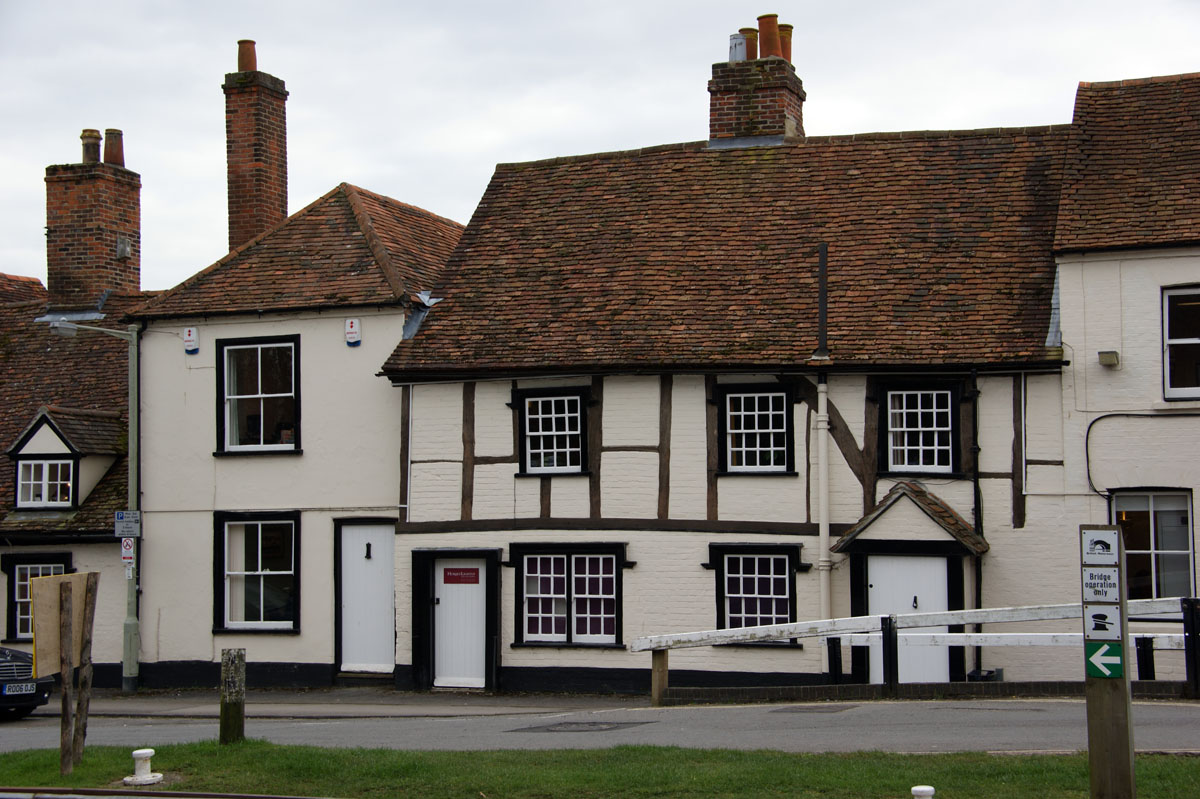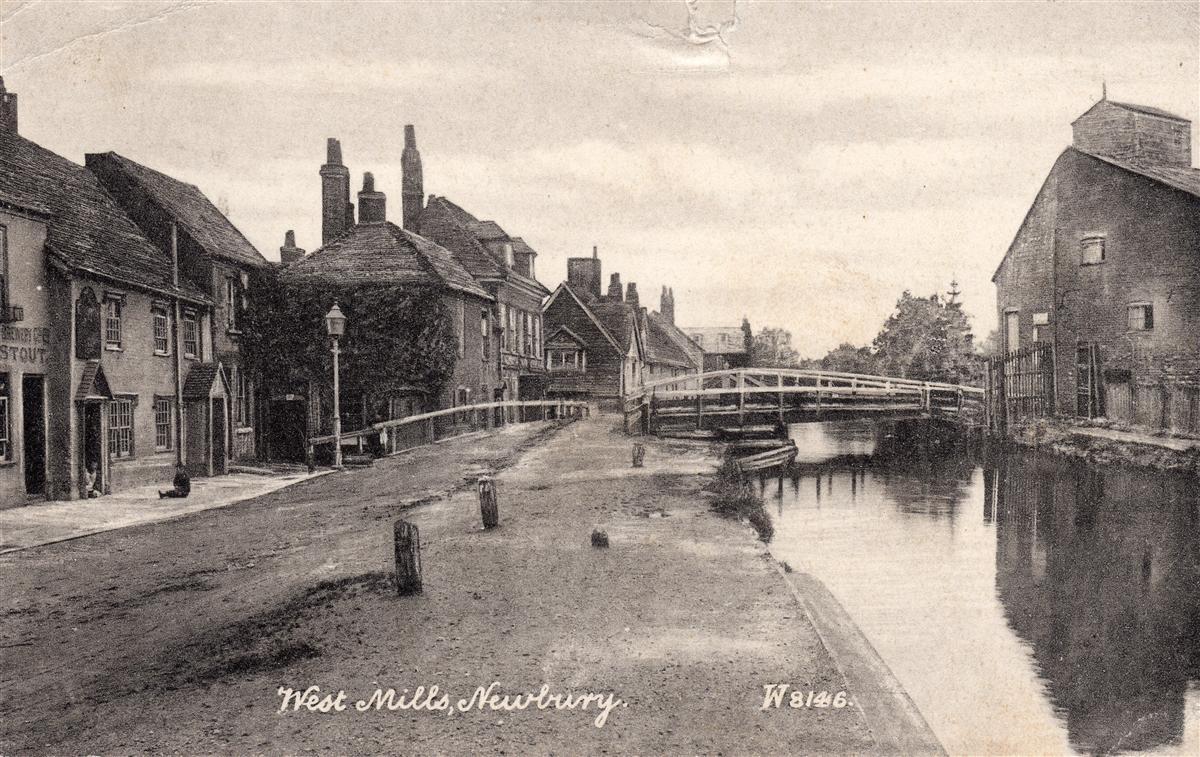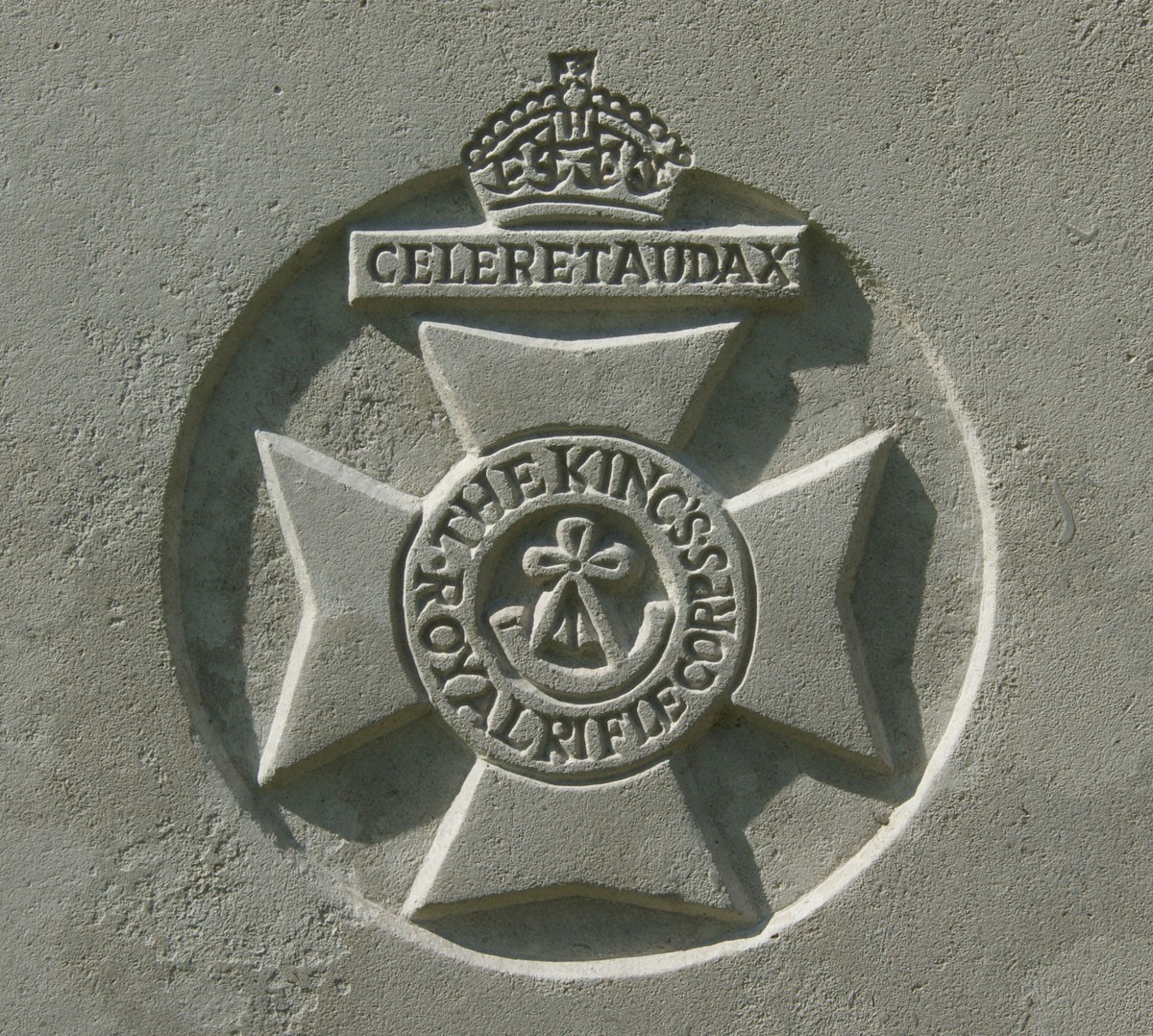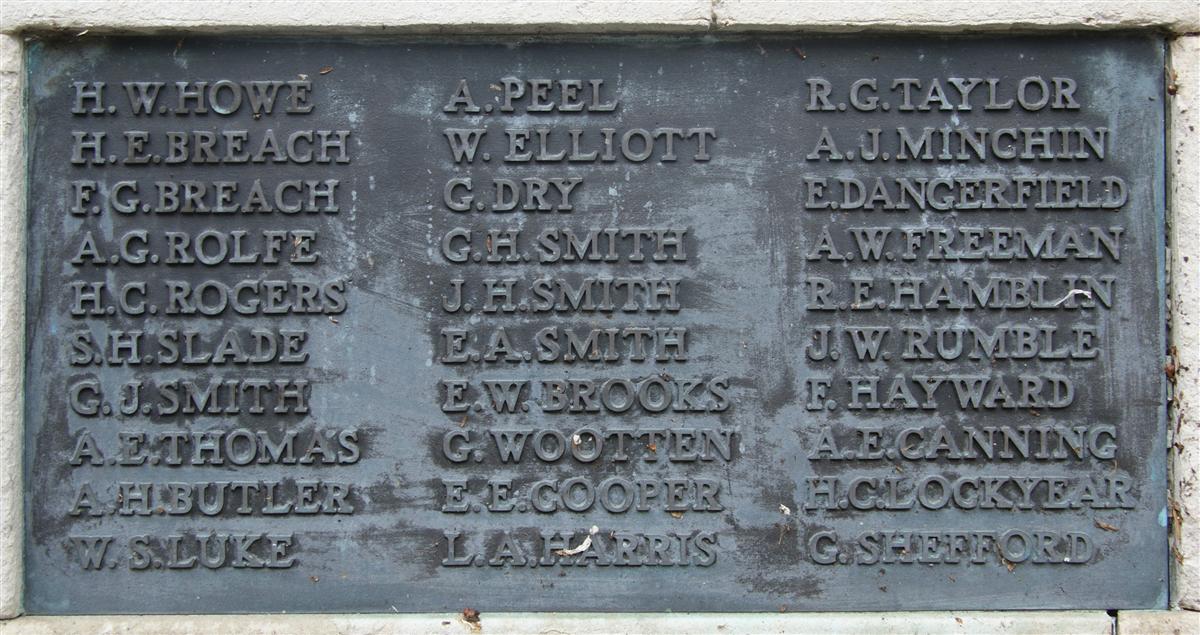Samuel Henry Slade
Private 11497 Samuel Henry Slade, 2nd Battalion, King's Royal Rifle Corps

16-18 West Mills, the Slades lived in No 18 (right) - formerly an almshouse, built c1476. Nos 16 & 17 were The Crown beerhouse until it was closed in 1914. |
Samuel Henry Slade (known as Henry) was born in Newbury in 1897, the son of Samuel Slade and his wife Annie née Lawrance. The Slades had 11 children in total: Alice Mary (born 1882), Catherine Emily (1883), George William (1885), Beatrice Mabel Mary (1886), Alice Ethel (1887), Lucy Ellen Selena (1888), Gertrude Annie (1890), Samuel Henry (1891), Rosina (1893), Samuel Henry (1897) and Hilda Florence (1900). As might be assumed from the presence of two Samuel Henrys in this list, not all the children survived childhood; Alice Mary, George William, Gertrude Anne and the first Samuel Henry all died within a few weeks of their births. However, seven children did survive to adulthood, the first to marry being Catherine, who married Charles Hillier, a brewer’s drayman from Kingsclere in 1904.
As well as the joy of seeing her first child marry, 1904 brought tragedy to Annie Slade’s life when her husband died around the same time aged only 48; he was buried in the Newtown Road Cemetery on 15 Jun 1904. The loss of the main breadwinner could be economically disastrous, but families with older children were better placed to cope; by the time Samuel died, several of his daughters were working and would have been able to contribute to the family budget. Nevertheless the most practical solution for a widow was to remarry. The birth of Dorothy Olive in 1906 suggests Annie had formed a relationship, but there is no evidence of a marriage.
More of her daughters married and left to start their own families. In 1907 Beatrice married Frederick George Shave, and in 1908 Lucy (known as Nelly) married Albert John Gore.

A contemporary view of West Mills, the Crown beerhouse far left, next door to the Slades' was run by members of the Lipscombe family for over 50 years. |
It is not known what happened to the surviving children, but it seems that their eldest sister, Catherine, may have taken them in. She was certainly the one Henry gave as his next of kin when he joined the army.
As a young lad Henry was involved in the Boy Scouts and Church Lads Brigade; organisations like this were pseudo-military in their structure, it would not be surprising if a lad involved with both would opt to join the army as a career – which is exactly what Henry did.
The exact date that Henry enlisted is not known, but his regimental number (11497) was probably issued in mid 1914, two or three months before the declaration of war in August. At this date Henry was still only sixteen years old; the British Army still recruits boys of that age – but then as now, young recruits like this are not expected to go into battle. At the age of eighteen they would be formally enlisted as fighting soldiers, but even then in 1914 the policy was clear, men would not be sent overseas to fight before they were nineteen years old. Despite this, Henry’s regiment, the King’s Royal Rifle Corps (KRRC), still sent him to France, where, according to the regimental medal rolls, he landed on 11 November 1914 – reaching his front line unit, the 2nd Battalion, KRRC before 22 November, thus qualifying for the award of a 1914 (or Mons) Star. The newspaper report of his death (below) states that he had served with the Expeditionary Force from the battle of Mons onward. This contradicts the medal roll information, but, nevertheless may be true – it is not unknown for a man returning to the front after a short spell in the UK recovering from a minor wound or sickness to be recorded as arriving in France for the first time.
At around this time, perhaps even while Henry was at home on the short leave most troops received prior to deployment abroad, his sister Rosina (Rose) married Albert Edwin Lipscombe.

The regimental badge of the Kings Royal Rifle Corps, as used on CWGC headstones. |
The date of the 22 November is the cut-off date for the award of the 1914 Star because it is the official end of the 1st Battle of Ypres . However, by the time Henry arrived his battalion had played their part in that particular battle (as demonstrated by the need for 196 reinforcements) and were in billets reorganising and preparing. After the arrival of the drafts the strength of the battalion was 579 men and 13 officers – still a long way short of the complement of a full strength battalion (1,007 officers and men). Another 418 officers and men arrived in late November, early December bringing the battalion as close to full strength as could be hoped for.
On 21 December the battalion left their billets to support, as reserve troops, an attempt to recapture some trenches in the Le Touret area that had recently been lost by a Gurkha battalion. The attack was successful, so much so that the battalion was not required to take part. The following day C & D Companies moved forward to man the captured trenches, which involved plenty of work to prepare them for defence against any counter-attack. On 24 December the whole battalion was withdrawn to billets where they spent a peaceful Christmas. On Boxing Day they were sent back to the line to man some trenches near Guinchy – trenches that were the best we have struck so far & they are in many places paved with bricks – luxury indeed! Though there was one mishap when a sentry accidentally wounded two of their officers; it is not easy to see how an accident wounded two men (unless the same bullet hit both officers) - one wonders what story lay behind this incident.
Appalling weather did not help – 31 December: Of 23 men sent up only 20 are here. One went sick, two lost their boots in the mud on the way up. One of our men has been stuck in the mud for 1 ½ hours and has fainted. A party is digging him out. Later that day a German attack succeeded in capturing a section of trench. Over the next few days various attempts were made to recapture the lost trenches the possession of which changed several times. Eventually things calmed a little and a new line was established before the battalion withdrew to billets in Cambrin. Despite being in billets and given the chance of a hot bath, the men were still up in the trenches in working parties improving the trenches etc.
On 10 January the battalion was back in action, carrying out an attack on an observation post and machine-gun post recently captured by the enemy. The initial attack captured the targets, but counter-attacks forced the abandonment of the machine-gun post; casualties were estimated at 20 killed, 40 wounded. The following evening the enemy shelled the observation post causing 5 casualties.
Henry was reported missing on 11 January, which does not really tie in with the information above from the battalion war diary. Even more confusion comes from the news of his death printed in the local paper:
Newbury Weekly News, 7 October 1915, p8 – Local War Notes
News was received on Thursday last by Mrs Hillier, of Kingsclere, of the death of Rifleman H S Slade, of the 2nd Battalion King’s Royal Rifles, who had been missing since January 11th. The information stated that Slade had died in Germany, but neither the date nor the cause had been given. The deceased young man had joined the Army before the war, and had served with the Expeditionary Force from the battle of Mons onward. His father and mother, who lived in West Mills, Newbury, are both dead, and his eldest sister received the intimation from the War Office. Slade had been a Scout, and a member of the Church Lads’ Brigade, and at the time of his death was only eighteen years of age. Another sister, Mrs Shave, of Pembroke-road, whose husband is in the 8th Berks, has received the cheering intimation that her husband is quite well after the recent fighting.
The suggestion that he died in Germany would imply that he was captured on the 10th, perhaps when the machine-gun post defences were overwhelmed. However, it is unlikely that this was the case. The Rector’s wife in Kingsclere, Mrs Find, made enquiries about Henry through the Red Cross, who enquired of the German authorities. As far as can be determined they received a negative response, in essence that although Henry’s ID tags had been recovered his burial place was unknown (beerdigungsort unbekannt). This was communicated to Mrs Find in a letter sent on 23 September, leading, no doubt, to the piece in the paper.
Such circumstances suggest that he died on the battlefield and, if he was buried it would have been in a mass grave as the Germans cleared up their newly held territory.
As he has no known grave, Henry is remembered (as Slade H S) on panel 33 of the memorial to the missing at Le Touret

Henry's name on Newbury War Memorial. (middle left) |
Locally he is remembered on tablet 10 of the Newbury Town War Memorial (S H Slade) and on the memorial board and roll of honour in St Nicolas’ Church (H S Slade).
It also appears possible that he is also on tablet 9 of the Newbury memorial as C H Slade.
Family
While Henry had no brothers, he did have a number of brothers-in-law - one of whom is mentioned in the newspaper item above.
Frederick George Shave the husband of Beatrice served in the 8th Battalion of the Royal Berkshire Regiment (Private 17873). He was a volunteer joining up in response to Lord Kitchener’s appeal for a new army. He did not go to France until August 1915, a few months after the battalion was deployed to the front. This might suggest that he did not volunteer until late 1914 and hence was not ready to go with the battalion initially; equally he could have been held back for some other reason (sickness, injury, etc). He remained with the battalion through several major battles before his luck ran out in the spring of 1918 when he was captured during the Germans’ great offensive.
Newbury Weekly News, 8 August 1908 – Local War Notes
Mrs F Shave, Pembroke Road, has received a letter dated Jun 2, stating that her husband, reported as missing 21st March 1918, is safe and a prisoner in Germany.
After a few months as a prisoner of war Frederick was returned to England and on 16 March was discharged to the Class Z Reserve; whilst he remained liable to recall if the Armistice did not hold, his war was over.
Frederick James Lispcombe was the younger brother of Henry’s sister, Rosina’s husband Albert; he died in 1918 while serving with the 13th Battalion of the Durham Light Infantry and also appears on the Newbury war memorial. His story is told here.

Find a memorial :
| Died this day: | |
| 15 January 1943 | |
| L C Lawrence | |
| Newbury |

Like this site? Show your appreciation through a donation to a great charity.